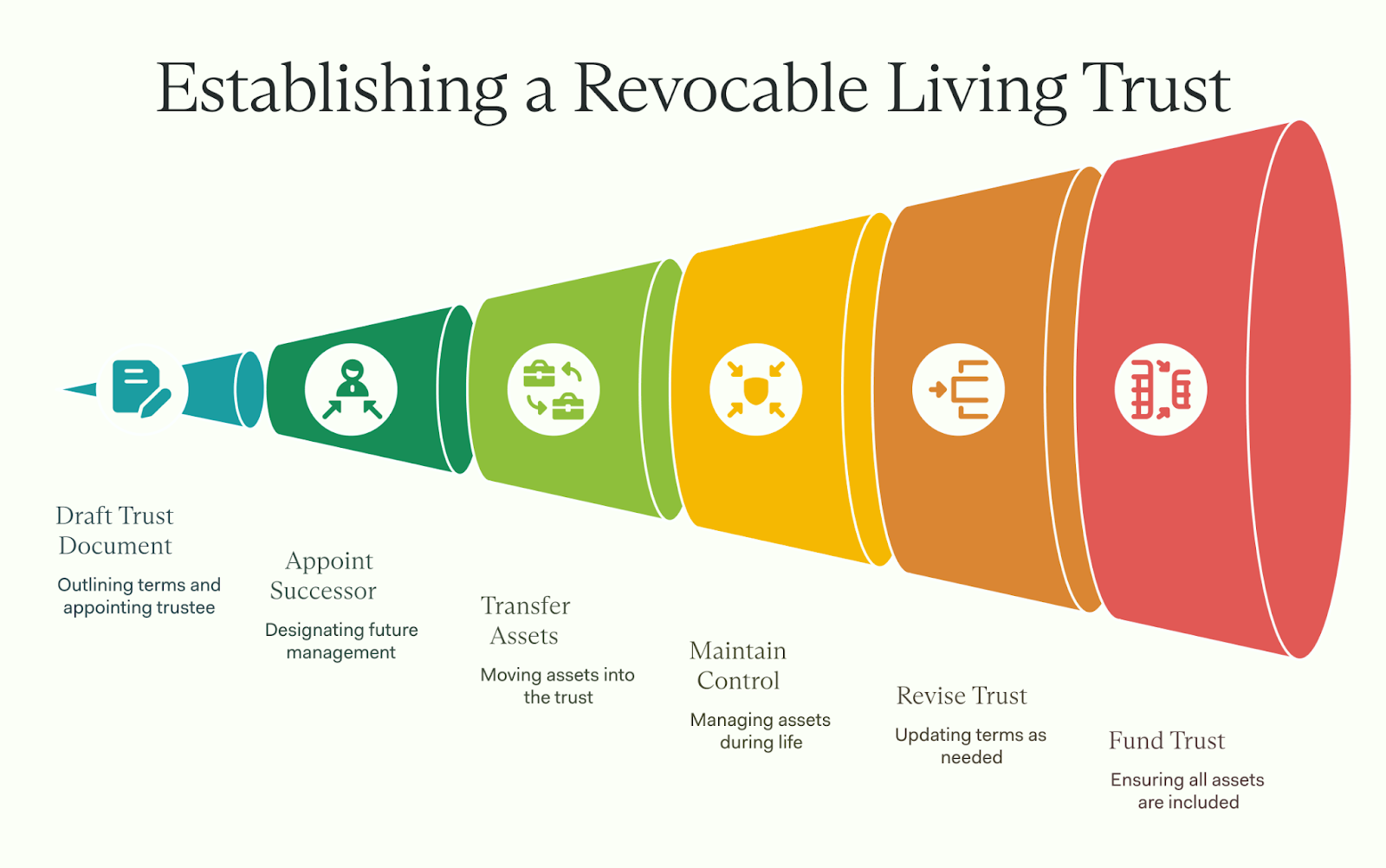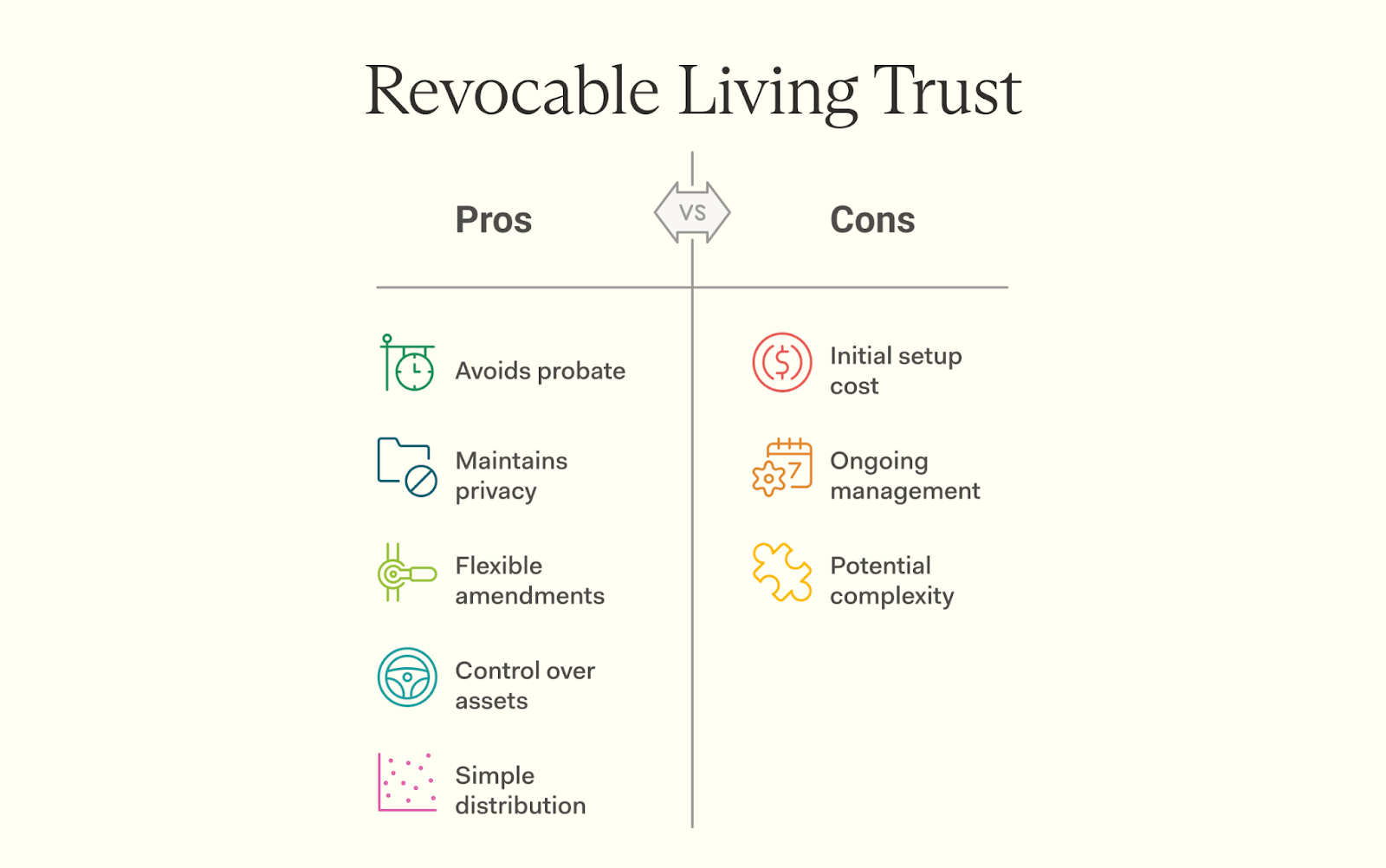Discover the essentials of a revocable living trust and how it can simplify estate planning. Read our practical guide for clarity and peace of mind.
Planning for your future assets doesn't have to be complicated. A revocable living trust is a practical tool that many people use in their estate planning.
This arrangement lets you keep control of your assets while you're alive but creates a smooth transfer process after you're gone. Unlike regular wills, a trust helps your family avoid the time-consuming probate process.
This guide explains what a revocable living trust is, how it works, and whether it might be right for your situation. Understanding your options now can save your loved ones significant stress and complications later.
This legal document allows you to manage your assets while you're alive and pass them on after death without probate. You can change or cancel it anytime.
The person who creates the trust is called the grantor. They also pick someone, a trustee, to manage the trust.
This type of trust helps keep private financial details out of public record. Your assets go straight to your chosen beneficiary after you die. This process skips court supervision, making things quicker and less costly for family members.

Creating a revocable living trust starts with moving your assets into the trust. This process lets you manage everything as if you still owned them, but technically, the trust does.
To manage your assets during your life, you'll need to establish a revocable living trust. It helps in transferring ownership of these assets easily.
These steps help establish and fund a revocable living trust effectively, shielding your financial affairs and streamlining asset distribution later on.
The trustee manages the revocable living trust. This person handles all assets transferred to the trust. They make sure everything runs smoothly. The trustee pays bills and keeps records.
They also follow the terms of the trust.
A successor trustee steps in if the original trustee cannot fulfill their duties. This could happen due to illness or death. The successor makes sure that assets are managed properly until they are distributed to beneficiaries of the trust.
Clear instructions help guide these actions, ensuring that wishes are honored.
The trust's assets require careful handling, with distribution occurring after your death or when specified.
A revocable living trust can help you avoid probate and keep your assets private. It also allows you to change or cancel the trust anytime, giving you more control over your estate.

Probate is the legal process after someone dies. It can be slow and costly. A revocable living trust helps avoid probate. You put your assets in this trust while you're alive. Once you pass, those assets go to your beneficiaries without court delays.
Assets held in a revocable trust do not go through probate. This keeps things private and simple for loved ones. The trust provides clear instructions on who gets what, which helps ease any confusion later on.
You stay in control until it's time for distribution. That way, your estate settles smoothly and quickly after you're gone.
Unlike a will, which goes through probate and becomes public, a trust remains private. This means the details of your estate stay out of the public eye.
Assets in a revocable trust are not subject to court proceedings after death. The management of the trust stays between you and your beneficiaries. This keeps financial decisions and distributions discreet—fewer people need to know about your affairs or assets transferred to the trust.
You can change or revoke a revocable living trust at any time while you're alive. This means you can update the terms, add assets, or remove them easily.
Life changes happen—like marriage, divorce, or new family members—and your trust can reflect those shifts quickly.
Another perk is that you remain in control. As the owner and trustee, you manage the assets inside the trust. If your needs change again, simply dissolve the trust if desired. No lengthy court process needed here! This adaptability makes a revocable living trust a smart estate planning tool for many people looking to retain control over their property and wishes.
A revocable living trust has its downsides. It won't give you immediate tax benefits, and it might require extra work to manage.
Unlike an irrevocable trust, assets in a revocable trust are still part of your estate. They are subject to estate taxes.
The trustee manages the assets, while the grantor typically reports the trust's income on their personal tax return, as the trust is regarded as a "grantor trust" for tax purposes.
There's no reduction in income or gift taxes either. Any earnings from the trust's assets remain taxable to you while you're alive. This means you keep paying those taxes as usual—even after funding the trust.
Estate planning often aims for tax efficiency, yet a revocable living trust may not help achieve that right away.
Managing a revocable living trust takes time and effort. You'll need to keep records of the assets in the trust. This includes property, bank accounts, and investment accounts.
You must also handle paperwork for transferring ownership of these assets to the trust, but it's important to note that certain assets, such as retirement accounts, should not be transferred into a revocable living trust due to potential negative tax implications.
Regular updates are needed too, especially if you change beneficiaries or add new assets. The work might seem challenging, but staying organized will make it easier to manage your trust effectively.
Managing a revocable living trust requires careful planning to ensure your assets are protected and distributed according to your wishes. A financial advisor can provide expert guidance on investment strategies and tax planning, helping you make the most of your trust while avoiding unnecessary complications.
A Farther financial advisor works alongside estate planning professionals to ensure everything is set up correctly. From transferring ownership to structuring your trust for long-term security, they help you navigate key financial decisions with confidence.
Make sure your trust is working for you. Connect with a Farther advisor today.
Creating a revocable living trust can be a smart step in your estate planning. It helps keep your assets safe and avoids the long probate process. Your trustee manages these assets while you're alive, keeping things simple.
After you pass, the trust quickly distributes them to beneficiaries without court delays.
Consider how this option fits with your financial goals. It's practical—easy to set up and change as needed. If you're unsure about creating one, reach out to a financial advisor for expert guidance.
A revocable living trust is an estate planning tool that allows you to transfer ownership of your assets into the name of the trust. You can act as your own trustee, managing the assets within the trust during your lifetime. This type of trust becomes irrevocable upon death.
Creating a revocable living trust involves working with an experienced estate planning attorney who can help set up the terms and conditions for managing and distributing your property in accordance with your wishes.
One main difference lies in how assets are handled after death - while both provide instructions on distribution, trusts offer avoidance of probate process which is public and could involve additional costs; whereas wills require court intervention.
Yes, one advantage of a revocable living trust over its counterpart – irrevocable living trusts – is flexibility; allowing you to alter or even dissolve it entirely during your lifetime if circumstances change.
While placing property in such trusts doesn't directly reduce federal estate tax liability, other provisions included might help minimize potential impact on gross estate value– something an expert attorney can guide you about.
In case incapacity strikes before demise, having appointed someone trustworthy – be it family member or bank/trust company – under durable power ensures continued smooth money management without court interference.